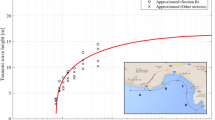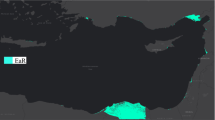Abstract
Tsunamis can represent a significant risk to the population and cause huge economic damage in many costal regions. In order to be able to identify risk hot spots and implement targeted risk reduction measures, decision makers need to have a clear picture of the risk situation in their countries or regions. This work reviews existing approaches for tsunami risk assessment and recommends a five-step process for assessing tsunami risk. As a case study, a qualitative risk assessment for a worst-case tsunami scenario was carried out to understand the tsunami risk to the population in Cádiz. Moreover, a sensitivity analysis of the tsunami hazard input parameters was performed as a strong influence of the variability of the input parameters on the resultant tsunami hazard and risk zonation maps was observed. The study shows that regardless of the assumptions made a non-negligible tsunami risk to Cádiz exists.









Similar content being viewed by others
References
AS/NZS 4360 (2004) Risk management. Standards Australia/Standards New Zealand
Australian Geomechanics Society (2000) Landslide risk management concepts and guidelines. Aust Geomech 35:1
Berryman K (2006) Review of tsunami hazard and risk in New Zealand. Institute of Geological and Nuclear Science, New Zealand
Birkmann J (ed) (2006) Measuring vulnerability to natural hazards: towards disaster resilient societies. United Nations University Press, New York
Birkmann J (2007) Risk and vulnerability indicators at different scales: applicability, usefulness and policy implications. Environ Hazards 7:20–31
Birkmann J, von Teichman K, Welle T, González M, Olabarrieta M (2010) The unperceived risk to Europe’s coasts: tsunamis and the vulnerability of Cadiz, Spain. Nat Hazards Earth Syst 10:2659–2675
Cox DC (1984) Importance of local contemporary reports of effects of historical tsunamis in tsunami risk analysis. Sci Tsunami Hazards 2(2):67–69
CPR (1999) Guidelines for quantitative risk assessment CPR 18E (purple book). CPR Committee for the Prevention of Disasters, The Hague
CSSC (2005) The tsunami threat to California: findings and recommendations on tsunami hazards and risks. Tsunami Safety Committee of the Seismic Safety Commission, CA
Curtis GD, Pelinovski EN (1999) Evaluation of tsunami risk for mitigation and warning. Sci Tsunami Hazards 17(3):187–192
Damaskinidou-Georgiadou A, Asce AM, Johnson WJ (1987) Evaluation of tsunami risk at the southwest coast of the Iberian Peninsula, In: Magoon OT (ed) Coastal zone ‘87. Proceedings of the fifth symposium on coastal and ocean management, Seattle, May 26–29, 1987. American Society of Civil Engineers, pp 3346–3358
Defra (2005) The threat posed by tsunami to the UK. Defra flood management. http://www.defra.gov.uk/environment/flooding/documents/risk/tsunami05.pdf. Accessed 6 July 2010
Granger K, Jones T, Leiba M, Scott G (1999) Community risk in Cairns: a multi-hazard risk assessment. Australian Geological Survey Organization, Canberra
Hébert H, Schindelé F, Heinrich P (2001) Tsunami risk assessment in the Marquesas Islands (French Polynesia) through numerical modelling of generic far-field events. Nat Hazards Earth Syst 1:233–242
ISO 31000:2009 Risk management: principles and guidelines. International Organization for Standardization, Geneva, Switzerland
Jelínek R, Krausmann E (2008) Approaches to tsunami risk assessment. EUR 23573 EN. European Communities, OPOCE, Luxembourg
Jonkman SN, Vrijling JK, Vrouwenvelder ACWM (2008) Methods for the estimation of loss of life due to floods: a literature review and a proposal for a new method. Nat Hazards 46(3):353–389
Kulikov EA, Rabinovich AB, Thomson RE (2005) Estimation of tsunami risk for the coasts of Peru and northern Chile. Nat Hazards 35:185–209
Lee YK (1979) Tsunami risk analysis, In: Hwang LS, Lee YK (eds) Tsunamis: proceedings of the national science foundation workshop, May 1979, Tetra Tech., Pasadena, pp 254–271
Legg MR, Borrero J, Synolakis CE (2003) Evaluation of tsunami risk to southern California coastal cities. NEHRP professional fellowship report. Earthquake Engineering Research Institute (EERI), CA
Lima VV, Miranda JM, Baptista MA, Catalao J, González M, Otero L, Olabarrieta M, Álvarez-Gómez JA, Carreño E (2010) Impact of a 1755-like tsunami in Huelva, Spain. Nat Hazards Earth Sys 10:139–148
Middelmann MH (ed) (2007) Natural hazards in Australia. Identifying risk analysis requirements. Geoscience Australia, Canberra
Nadim F, Glade T (2006) On tsunami risk assessment for the west coast of Thailand. In: Nadim F et al (eds) ECI conference on geohazards. Lillehammer, Norway, pp 1–13
Nakamura S (1978) On statistical tsunami risk of the Philippines. South East Asian Stud 15(4):581–590
NEAREST (Integrated observations from near shore sources of tsunamis: toward an early warning system) (2010). http://nearest.bo.ismar.cnr.it. Accessed 6 July 2010
Olabarrieta M, Medina R, González M, Otero L (2010) C3: a finite volume–finite difference hybrid model for tsunami propagation and run-up. Accepted for publication in computers and geosciences
Papadopoulos GA, Dermentzopoulos TH (1998) A tsunami risk management pilot study in Heraklion, Crete. Nat Hazards 18:91–118
Papathoma M, Dominey-Howes D (2003) Tsunami vulnerability assessment and its implications for coastal hazard analysis and disaster management planning, Gulf of Corinth, Greece. Nat Hazards Earth Syst 3:733–747
Papathoma M, Dominey-Howes D, Zong Y, Smith D (2003) Assessing tsunami vulnerability, an example from Herakleio, Crete. Nat Hazards Earth Syst 3:377–389
Pararas-Carayannis G (1988) Risk assessment of tsunami hazard. In: El-Sabah MI, Murty TS (eds) Natural and man-made hazards. D. Riedel, USA, pp 183–191
Post J, Wegscheider S, Mück M, Zosseder K, Kiefl R, Steinmetz T, Strunz G (2009) Assessment of human immediate response capability related to tsunami threats in Indonesia at a sub-national scale. Nat Hazards Earth Syst 9:1075–1086
Qinghai Z, Adams WM (1988) Tsunami risk analysis for China. Nat Hazards 1:181–185
Rascon OA, Villarreal AG (1975) On a stochastic model to estimate tsunami risk. J Hydraul Res 13(4):383–403
Rofi A, Doocy S (2006) Tsunami mortality and displacement in Aceh province, Indonesia. Disasters 30(3):340–350
Rynn J, Davidson J (1999) Contemporary assessment of tsunami risk and implication for early warnings for Australia and its island territories. Sci Tsunami Hazards 17(2):107–125
SAFER (Seismic Early Warning for Europe) (2010) http://www.saferproject.net. Accessed 6 July 2010
SCHEMA (Scenarios for Hazard-induced Emergencies Management) (2010) http://schemaproject.net. Accessed 6 July 2010
SEAHELLARC (Seismic Risk Assessment and Mitigation Scenarios in the Western Hellenic Arc) (2010) http://www.seahellarc.gr. Accessed 6 July 2010
Symões JZ, Afilhado A, Victor LM (1992) Assessing the tsunami risk using instrumental and historical records. Sci Tsunami Hazards 10(1):3–7
Synolakis CE, McCarthy D, Titov VV, Borrero J (1998) Evaluating the tsunami risk in California. In: California and the world ocean ‘97, ASCE, San Diego, pp 1225–1236
Thywissen K (2006) Core terminology of disaster reduction: a comparative glossary. In: Birkmann J (ed) Measuring vulnerability to natural hazards. UNU Press, Tokyo, pp 448–496
Tinti S, Armigliato A, Tonini R, Maramai A, Graziani L (2005) Assessing the hazard related to tsunamis of tectonic origin: a hybrid statistical-deterministic method applied to southern Italy coasts. J Earthq Tech 42(4):189–201
Tinti S, Tonini R, Pontrelli P, Pagnoni G, Santoro L (2008) Tsunami risk assessment in the Messina straits, Italy, with application to the urban area of Messina. Geophys Res Abstr 10:EGU2008-A-08045
TRANSFER (Tsunami Risk and Strategies for the European Region) (2010) http://www.transferproject.eu. Accessed 6 July 2010
UCA (2009) Scenario flooding and risk maps, probabilistic risk maps for Cádiz city and Huelva community. Risk reduction measures for Cádiz, deliverable D8.2 of the 6th European framework programme project TRANSFER. http://www.transferproject.eu/. Accessed 16 Mar 2011
UC-IGN (2009) Tsunami inundation maps along the south west Spanish coast, deliverable d7.1 of the 6th European framework programme project TRANSFER. http://www.transferproject.eu/. Accessed 16 Mar 2011
UNESCO-IOC (2009) Hazard awareness and risk mitigation in integrated coastal management (ICAM). Intergovernmental Oceanographic Commission. IOC manuals and guides, vol 50, ICAM Dossier No. 5, UNESCO, Paris
Wisner B, Blaikie P, Cannon T, Davis I (2004) At risk: natural hazards, people’s vulnerability and disasters, 2nd edn. Routledge, London
Zahibo N, Pelinovsky EN (2001) Evaluation of tsunami risk in the Lesser Antilles. Nat Hazards Earth Syst 1:221–231
Zitellini N, Gràcia E, Matias L, Terrinha P, Abreu MA, De Alteriis G, Henriet JP, Dañobeitia J, Masson DG, Mulder T, Ramella R, Somoza L, Diez S (2009) The quest for the Africa-Eurasia plate boundary west of the Strait of Gibraltar. Earth Planet Sci Lett 280(1–4):13–50
Acknowledgments
The authors acknowledge the European Union 6th Framework Programme Project TRANSFER in the frame of which this work was performed and funded.
Author information
Authors and Affiliations
Corresponding author
Rights and permissions
About this article
Cite this article
Jelínek, R., Krausmann, E., González, M. et al. Approaches for tsunami risk assessment and application to the city of Cádiz, Spain. Nat Hazards 60, 273–293 (2012). https://doi.org/10.1007/s11069-011-0009-0
Received:
Accepted:
Published:
Issue Date:
DOI: https://doi.org/10.1007/s11069-011-0009-0




